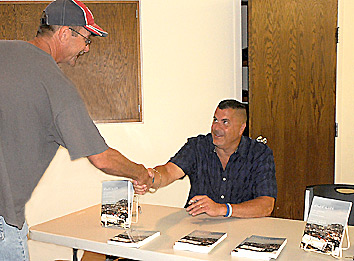
Mark Rohr, author of the book Joplin - The Miracle of the Human Spirit greets a visitor at a book signing he held recently at the Joplin Public Library.
Large in stature, Mark Rohr presents an imposing figure but those who have seen him react to the events following the May 22, 2011 tornado that tore through his city, know that his sensitive emotions overflow. It is with this characteristic, yet never yielding to the demands of his position as Joplin City Manager, that, in his book Joplin - The Miracle of the Human Spirit, he has chronicled the aftermath of the storm and his role in it.
"I have always felt that my entire life had been a preparation for a great challenge," Rohr writes. His curriculum vitae attests to having served at previous posts in cities in which he aggressively sought improvement and growth. "How grateful I would be for this level of experience," Rohr admits.
But, of course, no one can be prepared for the tragedy and hardship that comes from chaos and total devastation. Some of it becomes a learning experience and Rohr would be the first to admit that sometimes trial and error becomes the only viable method. In his retelling Rohr is able to provide for other city managers the "Ten Tenets of Disaster Management" that include staying in touch with the people, capitalizing on the good will of volunteers and donors and staying focused on what has to be done. In his book he outlines the four stages of disaster recovery as: search and rescue, debris removal, demolition and rebuilding. Achieving each stage is easier said than done.
What the reader sees is the progression from a third of the city in ruins to its stage one rebirth. The challenge chronicled by Rohr is in keeping Joplin's citizens motivated to rebuild and not leave and to generate outside interest that doesn't move on with the newest disaster.
Rohr says he was one of the first responders, crediting Fire Chief Mitch Randles with having first notified him of what had ensured, although even Randles couldn't know the extent. Rohr describes scenes of hysteria and horror, lifting dead bodies, for example, from the ruins of the pile of rubble that was once the Joplin Full Gospel Church on 20th and Michigan.
"Glancing at the young girl's lifeless body, I felt a wave of nausea," Rohr reveals, "as I thought of my own beautiful two year old daughter, Riley, whom I hoped had made it through the storm along with the rest of my family." As with other responders, he had time for only passing thoughts regarding the welfare of his own family.
What Rohr began to realize is that his role dictated that he cease hands-on rescue activity and begin to assume the role as administrator. That first required assessing the damage and setting an emergency operations center in motion. Initially, dealing with the Joplin crisis meant having been awake for over 24 hours and remaining civil enough in spite of exhaustion to deal with reporters, possible worsening weather and the visit by Governor Jay Nixon who had his own agenda but came with significant resources necessary for accounting for the missing (identification would require greater expertise) and designation of all of Missouri's low income housing credits to Joplin (a significant number of residents were either under-insured or not insured at all).
"I was careful to mention how important our citizens were to rebuilding the city and how vital it was that those in attendance continue to call Joplin home....., Rohr writes in describing his appeal during a town hall meeting held on the Missouri Southern State University campus. He recounts the roadblocks in getting people to sign right of way permits allowing for debris removal, convincing FEMA to supply enough temporary housing units and quickly and capitalizing on President Obama's visit.
Rohr realizes that he has to make pragmatic judgments based on facts alone. "To be successful in my leadership position," Rohr concludes, "I had to understand where I was and have an appreciation for those I would serve. My experiences with the citizens of Joplin in the aftermath of the tornado, has led me to a deeper appreciation of their conservative values."
Coining the terms "The Miracle of the Human Spirit" during one of his speeches at Cunningham Park, Rohr describes the countless examples of neighbors helping neighbors that took place in Joplin. The significance of this became clear after it was recognized by outsiders who contributed to an outpouring of aid, both monetary as well as otherwise.
When the book went to press Rohr noted that 110,000 registered volunteers had demonstrated "The Miracle of the Human Spirit." He praises them for coming to Joplin "to help their fellow man in their time of need."
Rohr writes:
The story of the Joplin tornado is not the powerful force of nature unleashed upon our city on that day in May. True, the storm ripped away and destroyed homes and personal possessions, but it did not destroy the values and beliefs of our citizens and volunteers. It did not destroy, but, in fact, revealed "The Miracle of the Human Spirit."
By writing the book Rohr wants to keep this spirit alive. He hopes people continue to direct this spirit into rebuilding the city and challenges others to incorporate the value of life and the giving spirit that has taken place here into their lives, whether they are experiencing a tragedy or not. It must be noted that he is donating profits from the book towards further disaster recovery efforts.

Title - Joplin - The Miracle of the Human Spirit
Author: Mark Rohr
Publisher: Tate Publishing and Enterprises LLC (May, 22, 2012)
$13.59 at Amazon.com/pp.257
ISBN-10: 1620247038/ISBN-13: 978-1620247037






Comments